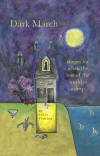Dark March
Flesh-eating hagfish, blue bejeweled garages, animated art, and a moveable geography. Dark March: Stories for When the Rest of the World is Asleep is filled with stories where sandspits are sentient, seagulls are cutthroat, and character conscientiousness is invariably fleeting. These hyperbole-infused short stories infuse ordinary settings with magic and imagination—they give just enough detail to be anchored in a possible universe but contain enough impossibility to buoy the characters above the predictable. Colin Fleming’s collection is pithy and witty, and manages to walk an interesting line between absurd existentialism, surrealist fantasy, and magical realism.
Flesh-eating hagfish, blue bejeweled garages, animated art, and a moveable geography. Dark March: Stories for When the Rest of the World is Asleep is filled with stories where sandspits are sentient, seagulls are cutthroat, and character conscientiousness is invariably fleeting. These hyperbole-infused short stories infuse ordinary settings with magic and imagination—they give just enough detail to be anchored in a possible universe but contain enough impossibility to buoy the characters above the predictable. Colin Fleming’s collection is pithy and witty, and manages to walk an interesting line between absurd existentialism, surrealist fantasy, and magical realism.
It would be impossible to describe the short stories in Dark March in enough detail to truly do them justice. However, the first in the collection easily typifies the themes that underlie the other seventeen—reduced to its simplest plot, “The Spit” is a story of an island that claims its own agency. The island begins as a swath of external factors. It is defined by its geographic form (weathering elements and the behavior of the surrounding ocean), its locale (it is simply the stage for other animals and their own dramas), and by the best term to describe the landmass (geographers and geologists become excited when the island becomes a spit, and are able to give themselves an important place in academic circles for its discovery). In short, the island-spit is the backdrop of the rest of the short story’s dramas.
However, and most interestingly, it is from that backdrop of external definitions that the island emerges to claim a story of its own—its own character, its own voice, its own place in the sun. When the geographer observes, “Don’t go anywhere, now,” the tossed-off phrase becomes more than a simple aside; the island takes the command as a challenge. And when it accepts that challenge, the setting morphs into its own character. Although the move from island to spit is a significant point, the detached narration of the story refuses to acknowledge the landmass’s newfound agency—the narrator continues to refer to the spit as an island.
“Yes, that is what you are,” [the geologist] declared, after a final day of study. “Connected to the land by a granite ledge that originates near the center of this . . . island. Pile of rocks.” The island, who was about to officially become a spit, wanted to thank the great man, for he assumed he could be no less than that. All of these years, and the mystery that he himself had no solution for, was at last solved. Was this exciting? Was this the point of all of the thousands of centuries?
And what can we make of such a story? A setting that becomes a character? A narrator that refuses to accept a setting-turned-character’s decisions? Minor characters that, while given more dialog and more colorful backstories, merely highlight the complex nature of character development that Fleming managed to create in a few short pages? We can certainly see different influences woven into the construction of each of the stories in Dark March—absurdist clipped dialog, magical characters that live past death, and surrealist non-sequitors that still provide a plot. In short, we see Fleming borrow particular elements from a myriad of genres and combine them into something uniquely his own.
Dark March: Stories for When the Rest of the World is Asleep is an interesting and fantastical read—a collection of stories that makes you ask yourself, “Wait. What? What on earth just happened?!?” and backtrack several paragraphs to make sure that you read the story “correctly.” The collection does well in its ability to infuse the extraordinary into the everyday.





